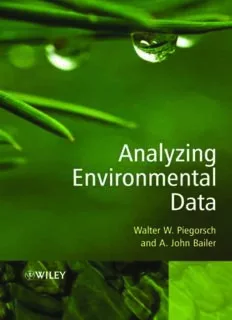
Analyzing Environmental Data PDF
Preview Analyzing Environmental Data
Analyzing Environmental Data AnalyzingEnvironmentalData W.W.PiegorschandA.J.Bailer (cid:1)2005JohnWiley&Sons,Ltd ISBN:0-470-84836-7(HB) Analyzing Environmental Data Walter W. Piegorsch University of South Carolina Columbia, South Carolina A. John Bailer Miami University Oxford, Ohio Copyright(cid:1)2005 JohnWiley&Sons,Ltd,TheAtrium,SouthernGate, Chichester,WestSussexPO198SQ,England Telephone (þ44)1243779777 Email(forordersandcustomerserviceenquires):[email protected] VisitourHomePageonwww.wileyeurope.comorwww.wiley.com AllRightsReserved.Nopartofthispublicationmaybereproduced,storedinaretrievalsystemor transmittedinanyformorbyanymeans,electronic,mechanical,photocopying,recording,scanningor otherwise,exceptunderthetermsoftheCopyright,DesignsanPatentsAct1988orunderthetermsof alicenceissuedbytheCopyrightLicensingAgencyLtd,90TottenhamCourtRoad,LondonW1T4LP, UK,withoutthepermissioninwritingofthePublisher.RequeststothePublishershouldbeaddressed tothePermissionsDepartmentJohnWiley&Sons,Ltd,TheAtrium,SouthernGate,Chichester, WestSussexPO198SQ,England,[email protected],orfaxedto(þ44)1243770620. Thispublicationisdesignedtoprovideaccurateandauthoritativeinformationinregardtothesubject mattercovered.ItissoldontheunderstandingthatthePublisherisnotengagedinrendering professionalservices.Ifprofessionaladviceorotherexpertassistanceisrequired,theservicesofa competentprofessionalshouldbesought. OtherWileyEditorialOffices JohnWiley&Sons,Inc.111RiverStreet,Hoboken,NJ07030,USA Jossey-Bass,989MarketStreet,SanFrancisco,CA94103-1741,USA Wiley-VCHVerlagGmbH,Boschstr.12,D-69469Weinheim,Germany JohnWiley&SonsAustraliaLtd,33ParkRoad,Milton,Queensland,4064,Australia JohnWiley&Sons(Asia)PteLtd,2ClementiLoop#02-01,JinXingDistripark,Singapore129809 JohnWiley&SonsCanadaLtd,22WorcesterRoad,Etobicoke,Ontario,Canada,M9W1L1 Wileyalsopublishesitsbooksinavarietyofelectronicformats.Somecontentthatappearsinprint maynotbeavailableinelectronicbooks. LibraryofCongressCataloginginPublicationData Piegorsch,WalterW. Analyzingenvironmentaldata/WalterW.Piegorsch,A.JohnBailer. p. cm. Includesbibliographicalreferencesandindexes. ISBN0-470-84836-7(acid-freepaper) 1. Environmentalsampling. 2. Regressionanalysis. 3. Correlation(Statistics) I. Bailer, A.John. II. Title. GE45.S25P542005 363.70007207—dc22 2004057769 BritishLibraryCataloguinginPublicationData AcataloguerecordforthisbookisavailablefromtheBritishLibrary ISBN0-470-84836-7(HB) Typesetin10/12ptTimesbyIntegraSoftwareServicesPvt.Ltd,Pondicherry,India PrintedandboundinGreatBritainbyTJInternationalLtd,Padstow,Cornwall Thisbookisprintedonacid-freepaperresponsiblymanufacturedfromsustainableforestry inwhichatleasttwotreesareplantedforeachoneusedforpaperproduction. To Karen and Jenny for their patience and encouragement; to Sara, Jacob, Chris, and Emily for sharing time with research; and to our readers with thanks for their interest. Contents Preface xiii 1 Linear regression 1 1.1 Simple linear regression 2 1.2 Multiple linearregression 10 1.3 Qualitative predictors: ANOVA and ANCOVA models 16 1.3.1 ANOVAmodels 16 1.3.2 ANCOVA models 20 1.4 Random-effectsmodels 24 1.5 Polynomial regression 26 Exercises 31 2 Nonlinear regression 41 2.1 Estimation and testing 42 2.2 Piecewise regressionmodels 44 2.3 Exponential regression models 55 2.4 Growthcurves 65 2.4.1 Gompertz model 66 2.4.2 Logisticgrowth curves 69 2.4.3 Weibull growth curves 79 2.5 Rational polynomials 83 2.5.1 Michaelis–Menten model 83 2.5.2 Morgan–Mercer–Flodin model 87 2.6 Multiple nonlinear regression 89 Exercises 91 3 Generalized linear models 103 3.1 Generalizing the classical linear model 104 3.1.1 Non-normal dataandthe exponential class 104 3.1.2 Linkingthe mean response tothe predictorvariables 106 3.2 Theory ofgeneralized linear models 107 3.2.1 Estimation via maximum likelihood 108 3.2.2 Deviance function 109 viii CONTENTS 3.2.3 Residuals 112 3.2.4 Inference and modelassessment 113 3.2.5 Estimationvia maximum quasi-likelihood 116 3.2.6 Generalized estimatingequations 117 3.3 Specific forms of generalized linearmodels 121 3.3.1 Continuous/homogeneous-variancedataGLiMs 121 3.3.2 BinarydataGLiMs (including logistic regression) 124 3.3.3 Overdispersion: extra-binomial variability 135 3.3.4 Countdata GLiMs 141 3.3.5 Overdispersion: extra-Poisson variability 149 3.3.6 Continuous/constant-CV dataGLiMs 152 Exercises 158 4 Quantitative risk assessmentwith stimulus-response data 171 4.1 Potency estimationfor stimulus-response data 172 4.1.1 Medianeffective dose 172 4.1.2 Other levels ofeffective dose 176 4.1.3 Other potency measures 178 4.2 Risk estimation 180 4.2.1 Additional risk and extra risk 180 4.2.2 Risk atlow doses 187 4.3 Benchmark analysis 190 4.3.1 Benchmark dose estimation 190 4.3.2 Confidence limitson benchmark dose 192 4.4 Uncertainty analysis 193 4.4.1 Uncertainty factors 194 4.4.2 MonteCarlo methods 196 4.5 Sensitivityanalysis 200 4.5.1 Identifying sensitivity toinputvariables 200 4.5.2 Correlation ratios 204 4.5.3 Identifying sensitivity tomodelassumptions 206 4.6 Additional topics 206 Exercises 207 5 Temporal dataand autoregressive modeling 215 5.1 Timeseries 215 5.2 Harmonic regression 216 5.2.1 Simple harmonic regression 217 5.2.2 Multiple harmonicregression 221 5.2.3 Identifying harmonics: Fourier analysis 221 5.3 Autocorrelation 233 5.3.1 Testing forautocorrelation 233 5.3.2 The autocorrelation function 235 5.4 Autocorrelated regression models 239 5.4.1 AR models 239 5.4.2 Extensions: MA, ARMA, and ARIMA 241 CONTENTS ix 5.5 Simple trend andintervention analysis 242 5.5.1 Simplelinear trend 243 5.5.2 Trendwithseasonality 243 5.5.3 Simpleintervention ata known time 248 5.5.4 Change intrend at aknown time 249 5.5.5 Jump and change intrend ata known time 249 5.6 Growthcurves revisited 254 5.6.1 Longitudinal growthdata 254 5.6.2 Mixed models forgrowthcurves 255 Exercises 264 6 Spatially correlated data 275 6.1 Spatialcorrelation 275 6.2 Spatialpointpatternsand complete spatial randomness 276 6.2.1 Chi-square tests 277 6.2.2 Distance methods 281 6.2.3 Ripley’s Kfunction 283 6.3 Spatialmeasurement 287 6.3.1 Spatialautocorrelation 288 6.3.2 Moran’s Icoefficient 290 6.3.3 Geary’sc coefficient 292 6.3.4 The semivariogram 293 6.3.5 Semivariogrammodels 296 6.3.6 The empirical semivariogram 297 6.4 Spatialprediction 302 6.4.1 Simplekriging 304 6.4.2 Ordinarykriging 306 6.4.3 Universal kriging 307 6.4.4 Unknowng 309 6.4.5 Two-dimensionalspatialprediction 312 6.4.6 Krigingundera normal likelihood 314 Exercises 323 7 Combiningenvironmental information 333 7.1 Combining P-values 334 7.2 Effect size estimation 337 7.3 Meta-analysis 343 7.3.1 Inverse-variance weighting 343 7.3.2 Fixed-effectsand random-effects models 346 7.3.3 Publication bias 349 7.4 Historical control information 351 7.4.1 Guidelines for using historical data 352 7.4.2 Target-vs.-control hypothesistesting 353 Exercises 358 x CONTENTS 8 Fundamentalsof environmental sampling 367 8.1 Sampling populations – simplerandom sampling 368 8.2 Designs toextendsimplerandom sampling 376 8.2.1 Systematicsampling 376 8.2.2 Stratified random sampling 377 8.2.3 Cluster sampling 383 8.2.4 Two-stage cluster sampling 386 8.3 Specialized techniques forenvironmental sampling 388 8.3.1 Capture–recapture sampling 388 8.3.2 Quadratsampling 391 8.3.3 Line-intercept sampling 392 8.3.4 Ranked set sampling 394 8.3.5 Compositesampling 398 Exercises 401 A Review of probabilityand statistical inference 411 A.1 Probability functions 411 A.2 Families of distributions 414 A.2.1 Binomial distribution 415 A.2.2 Beta-binomial distribution 415 A.2.3 Hypergeometric distribution 416 A.2.4 Poisson distribution 417 A.2.5 Negative binomialdistribution 417 A.2.6 Discrete uniform distribution 418 A.2.7 Continuousuniform distribution 418 A.2.8 Exponential, gamma, and chi-square distributions 418 A.2.9 Weibull and extreme-value distributions 419 A.2.10 Normaldistribution 419 A.2.11 Distributions derived from thenormal 421 A.2.12 Bivariatenormal distribution 424 A.3 Random sampling 425 A.3.1 Randomsamples and independence 425 A.3.2 The likelihood function 425 A.4 Parameterestimation 426 A.4.1 Leastsquares and weightedleast squares 426 A.4.2 The method ofmoments 427 A.4.3 Maximumlikelihood 427 A.4.4 Bias 428 A.5 Statistical inference 428 A.5.1 Confidence intervals 429 A.5.2 Bootstrap-based confidenceintervals 430 A.5.3 Hypothesis tests 432 A.5.4 Multiple comparisonsand theBonferroni inequality 434 CONTENTS xi A.6 The delta method 435 A.6.1 Inferenceson a function ofan unknown parameter 435 A.6.2 Inferenceson a function ofmultiple parameters 437 B Tables 441 References 447 Authorindex 473 Subject index 480
Description: